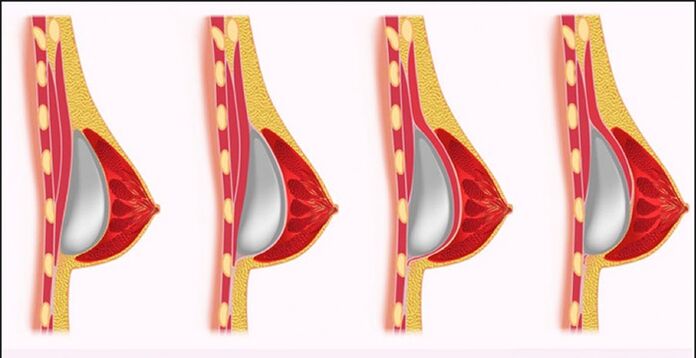Shape correction, breast augmentation is one of the most popular plastic surgery procedures. With the help of mammoplasty, you can correct congenital or acquired breast defects, restore volume, elasticity after childbirth and breastfeeding. Correctly performed surgery helps a woman become more attractive, more self-confident.
Indications for surgery
- Descent and decrease in the elasticity of the mammary glands (mastoptosis).
- Increased breast volume, maintaining its tone and position (macropathy).
- Reduction of mammary glands after lactation.
- Small breasts (micromastia).
- Increased breast volume in men (gynecomastia).
Types of Mammoplasty
Endoprosthesis of mammary glands
The operation involves installing silicone prostheses (implants) in the mammary glands. The choice of the incision site is compatible with the woman. The implant is placed under the pectoral muscle and, if the breast volume allows, between the muscle and the mammary gland. The incision is sutured, no drainage is required. The nipple and areola increase in size after surgery.
breast implants
Silicone or polyurethane endoprostheses correct the volume, shape of the bust, give a feeling of natural body tissues.
The useful life of implants is over 15 years, after which its replacement is recommended.

The products differ on several indicators:
Reduction Mammoplasty
In performing this type of surgery, the fat and breast tissue are partially removed, their size changes, and a new shape is given.
Excision of excess tissue reduces the likelihood of cancer.
Reduction mammoplasty options:
mastopexy
Breast lift without implants is possible in several ways:
stages of operation
For an excellent plastic surgery outcome, high-quality medical care at all three steps is important. The preparatory period lasts 1-2 weeks. Actual surgical intervention takes 1 to 4 hours.
Full recovery occurs in 1, 5 months.
Preparing for Mammoplasty

The operation is carried out not earlier than one year after the end of lactation. 2 weeks before surgery, it is forbidden to take hormonal contraceptives, aspirin and preparations containing salicylates.
You must stop drinking alcohol, smoking.
In preparation, the research is necessarily carried out:
- general and biochemical blood tests;
- electrocardiogram;
- blood test for anticoagulants (coagulogram);
- Ultrasound of the mammary glands;
- general urine analysis
- test for hepatitis viruses and HIV.
The course of surgical intervention

The bust plastic surgery is performed under general anesthesia. A special type is the expanding dermotension. It is used to increase breast volume with lack of proper tissue and large implant sizes. The procedure is carried out in 2 steps. First, an expander is installed to gradually stretch the breast tissue for 1, 5–2 months.
When the desired size is reached, an endoprosthesis is placed in the breast.
Operational incision methods:
Rehabilitation after mammoplasty

If the operation was uncomplicated, the patient stays up to 3 days in the hospital. After discharge, dressings are required. Moderate pain in the intervention area that occurs in the first few days is considered natural. The feeling of tightness in the skin is possible due to postoperative edema, which diminishes after about 5-7 days.
After 4–6 weeks, the breast sags slightly, looks more natural, and capsules form around the implants.
Successful recovery rules:
- Do not carry the shoulder girdle, do not lift weights.
- Do not visit fitness clubs, swimming pools, saunas, baths.
- Sleep on your back.
- Don't raise your hands.
- After breast augmentation, be sure to wear compression garments.
Possible complications
- Capsular contracture. The body forms a shell around the endoprosthesis, which can lead to its displacement, violation of the symmetry of the mammary glands and their hardening.
- Infection. Infection occurs during the operation due to violation of asepsis rules or after non-compliance with the antiseptic standards of care. The particular risk period is 1 week after the operation.
- Keloid, hypertrophic scars. They appear if the body is predisposed to their formation. The formations look like dense ridges that rise above the surface of the skin and detract from the appearance of the breast.
- Accumulation of blood, serous fluid (hematoma, seroma) and, consequently, a darkening of the skin color. It occurs when blood vessels, lymph vessels are damaged during surgery or during the recovery period. The complication appears due to low blood clotting, marked increase in blood pressure, incorrectly sized endoprosthesis.
- Reduction or loss of sensation in the nipples, areolas. It often occurs when large breasts are reduced with breast reduction surgery due to nerve damage.
- Implant rupture. This is due to the thin shell often found in inexpensive dentures. The salt filling is easily absorbed by the body without causing damage. Damage to an endoprosthesis with a cohesive gel is not always noticeable, but it is dangerous if silicone enters the body's tissues.
Breastfeeding after surgery

The safest operation is through an incision in the armpit (transaxillary) or under the breast (submammary).
About a year after surgery, breastfeeding is allowed.
Lactation problems can occur in the following cases:
- The endoprosthesis is placed to compress the mammary glands, reducing the volume of milk they produce.
- A cut along the areola is more likely to damage the nerve endings around the nipple.
- The reducing plastic, associated with the reduction in the size of the breasts, disorganizes the milk ducts, blocking their functions.
In which cases is breast plastic surgery contraindicated?
- Cardiovascular diseases, varicose veins (thrombophlebitis, thrombosis).
- Severe forms of mastopathy.
- Oncology.
- Blood clotting disorders, diabetes mellitus.
- Infectious diseases (ARVI, influenza).
- Neurological, mental disorders.
- Pregnancy, breastfeeding.
- Under 18 years old.
Advantages and Disadvantages of Mammoplasty

Advantages of Plastic Breast Correction:
- Application of modern interventions.
- Correction of congenital and acquired defects of the mammary glands.
- Pronounced and long-lasting aesthetic effect.
- Short transaction terms.
- The ability to choose the shape and material of the stent graft at will.
- Preservation of lactation capacity.
Possible disadvantages include:
- Skin incision marks - stitches, scars (unless special absorbable materials have been used).
- Threat of complications (infection, breast deformity, bleeding).
- The need for stent replacement every 10-15 years.
- The high cost of mammoplasty.
- The need for general anesthesia.
- Painful sensations in the first postoperative days.
- The need to constantly wear compression underwear.
- A long period of rehabilitation (several months to a year) with refusal of sports, physical activity, pregnancy, breastfeeding.


























